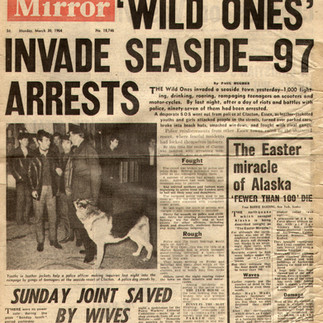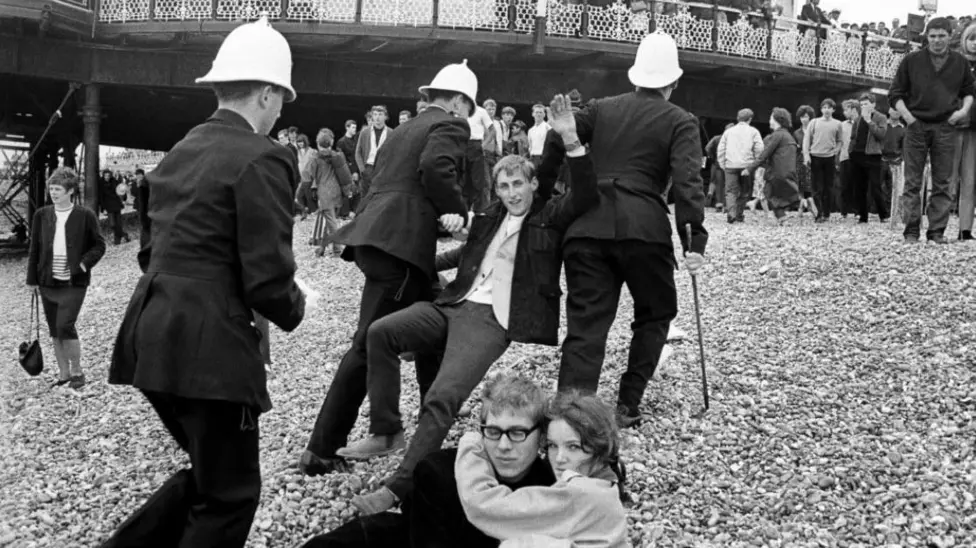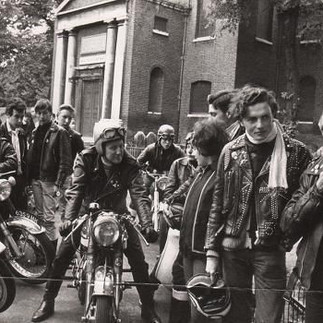The Mods and Rockers ‘Riots’ at English Seaside Towns: A Cultural Clash

In the early 1960s, the beaches of the English seaside became unlikely battlegrounds. Young people from across the country descended on towns like Clacton, Margate, Brighton, and Hastings, turning these traditional holiday resorts into sites of conflict and media hysteria. These incidents are commonly referred to as the "Mods and Rockers riots," though the scale and severity of these disturbances have been subject to much debate.
The disturbances, often portrayed as riots, symbolised a broader generational and cultural divide in post-war Britain. The tensions that arose between Mods and Rockers, two distinct youth subcultures, marked a significant chapter in British social history and the evolving identity of the young working class.
Who Were the Mods and Rockers?
The Mods and Rockers, while both products of post-war youth culture, were starkly different in their appearance, lifestyle, and values.
Mods (short for ‘modernists’) were known for their sharp suits, clean-cut style, and an affinity for scooters, particularly the Vespa and Lambretta. Mods were heavily influenced by modern jazz, soul, and rhythm and blues, creating a stylish and sophisticated urban identity. Their taste in fashion, music, and Italian-inspired scooters symbolised a break from the past and a desire for modernity and individuality.

Rockers, on the other hand, were often associated with leather jackets, greased-back hair, and powerful motorbikes. Their musical tastes leaned towards rock and roll, and they embraced a lifestyle that celebrated the rebelliousness of the open road. Rooted in a more traditional working-class identity, Rockers were sometimes seen as embodying a sense of resistance to the changes that were sweeping through post-war British society.

These subcultures, while enjoying their own distinct cultures, clashed over their respective lifestyles and, as often happens with youth movements, their competition for identity and space played out in public settings.
The Spark of Tensions
Though there had been isolated skirmishes between Mods and Rockers in earlier years, Easter weekend 1964 became the flashpoint. The long weekend provided the perfect opportunity for young people to escape to seaside resorts, where their paths inevitably crossed. Tensions that had been simmering in smaller gatherings now boiled over.
Clacton (Easter Weekend, 1964)
The first significant outbreak of violence occurred in Clacton-on-Sea over Easter weekend in 1964. This Essex town saw crowds of Mods and Rockers descend, their numbers swelled by the traditional Easter holiday rush. Though the actual incidents of violence were relatively minor, with some broken windows, petty vandalism, and a few physical altercations, the press exaggerated the events.
Headlines screamed of riots and pitched battles, fuelling a moral panic. National newspapers reported the events with sensational language, depicting the seaside as being overrun by hooliganism. In reality, only a small number of arrests were made, and much of the damage was minimal. However, the media’s portrayal painted a different story, one of chaos and destruction.
Margate (Whitsun Bank Holiday, 1964)
After Clacton, the next significant clash occurred in Margate during the Whitsun bank holiday in May 1964. Hundreds of Mods and Rockers arrived in the Kent seaside town, and the rising tensions between the two groups spilled over into violence. Fights broke out along the beach and promenade, with reports of running battles and a few instances of serious injury.
Once again, the media took hold of the story, amplifying the scale of the violence and contributing to a growing national concern about the state of British youth. Images of Mods and Rockers clashing on the beach, throwing deckchairs and fighting in the streets, became emblematic of the period.
Brighton (Whitsun Bank Holiday, 1964)
Following Margate, the Whitsun bank holiday disturbances reached their peak in Brighton. On 17 and 18 May 1964, the clashes between Mods and Rockers gained national notoriety. Brighton, known for its elegant Regency architecture and its appeal as a sophisticated seaside resort, was plunged into disorder.
The violence in Brighton was more sustained and intense than in Clacton or Margate. As the two groups faced off along the beach and in the streets, they hurled deckchairs and debris at each other and local businesses. The fighting continued well into the night, forcing the police to intervene heavily. The iconic image of Mods fleeing from baton-wielding police officers down Brighton's pebbled beaches has since become one of the most enduring symbols of the clashes.
In total, over 1,000 youths were involved, and around 76 people were arrested. While the disturbances in Brighton were serious, once again, the level of violence was less severe than the media suggested. Nonetheless, these events cemented the Mods and Rockers in the public imagination as lawless and out of control.
Hastings (May 1964)
In the same period, Hastings, another seaside town, witnessed its own share of disturbances. While less well-documented than the events in Clacton, Margate, and Brighton, Hastings saw smaller-scale confrontations between Mods and Rockers, as the Whitsun holiday violence rippled along the south coast.
Similar to other towns, the fighting involved skirmishes on the beach and pier, with local businesses caught in the crossfire. As in previous cases, police were deployed to quell the unrest, and arrests were made, though the scale of the disturbance did not reach the same heights as in Brighton.
The Role of the Media and Moral Panic
A critical aspect of the Mods and Rockers ‘riots’ is the role played by the media. While there were indeed disturbances in the aforementioned towns, many historians argue that the events were greatly exaggerated by sensationalist reporting. Headlines referred to the incidents as “riots,” though in truth, the violence was sporadic and often involved only a minority of those present.
The media’s portrayal contributed to a wider moral panic about the state of youth culture in Britain. Newspapers were filled with stories about the degeneracy of the younger generation, framing the Mods and Rockers as symbols of social decay. This panic was fuelled by a wider concern among older generations, many of whom were unnerved by the changes in youth culture, particularly in fashion, music, and attitudes towards authority.
Stan Cohen’s seminal work, Folk Devils and Moral Panics (1972), delves into the way the Mods and Rockers were turned into ‘folk devils,’ or scapegoats, for broader societal anxieties. Cohen’s analysis demonstrates how the media and public discourse amplified these incidents, turning them into symbols of youth rebellion and moral decline.
Aftermath and Legacy
By the mid-1960s, the tensions between Mods and Rockers had largely dissipated. The emergence of new youth subcultures, such as the hippies and skinheads, shifted attention away from the Mods and Rockers. However, the impact of the ‘riots’ at Clacton, Margate, Brighton, and Hastings continued to resonate.
The incidents highlighted the cultural divide in post-war Britain and the growing independence of the younger generation. They also exemplified how youth subcultures could come to be seen as threats to the established social order, especially when filtered through the lens of a sensationalist media.
Today, the Mods and Rockers clashes are remembered as a defining moment in British youth culture. They illustrate how the post-war generation used fashion, music, and identity to assert their place in a rapidly changing society.
References
Cohen, S. (1972). Folk Devils and Moral Panics: The Creation of the Mods and Rockers. London: MacGibbon & Kee.
Hebdige, D. (1979). Subculture: The Meaning of Style. London: Methuen.
Thompson, P. (1993). The Mods and Rockers: A Clash of Cultures. London: Routledge.

































